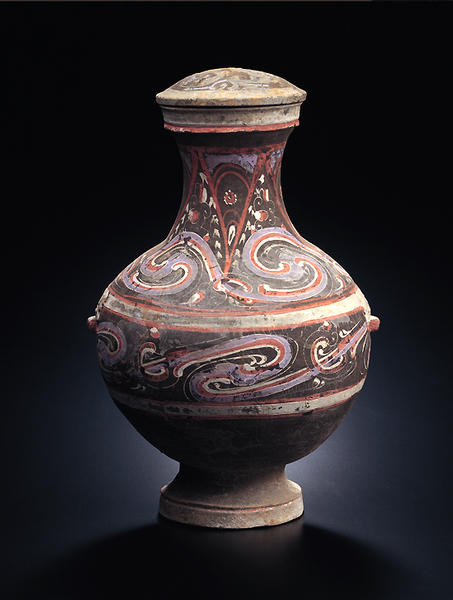雲気文鍾(壺)
- 中国
- 中国・前漢時代
- 前206-後9年
- 土器に着彩
- H-55.8 D-34
この壷の形は商時代(前1600-1028頃)の青銅器を写している。東周時代(前475-221)後期には儀式や日常の使用に青銅器を用いることは減少する一方、漆壷が広く人気を獲得した。しかし漆器は、製造して墓に納めるには非常に費用がかかるため、前漢時代には陶製の写しが埋葬の為に製造されはじめた。東周時代には織物の文様は、中国の他の多くの芸術、特に青銅器と漆器にみられる意匠に劇的な衝撃を与えた。前漢時代までには、中国の不死に対する霊的な関心を反映する、織物に由来する意匠が墓壁や陶製の墓の器を装飾しはじめた。「長生」と呼ばれる前漢時代の織物の意匠は、この作品に見出される書道的な雲形文様に対しての着想の源であった。
Catalogue Entry
The shape of hu vessels can be traced to bronze vessels of the Shang period (about 1600-1028 B.C.). During the late Eastern Zhou period (475-221 B.C.), the use of bronze vessels for ritual and everyday use declined, whereas lacquered hu vessels gained in popularity.1 But as lacquerware was extremely costly to create and then bury in tombs, in the Western Han period ceramic copies began to be produced for interment.2
During the Eastern Zhou period textile patterns had begun to have a dramatic impact on the designs found on many of China's other arts, particularly on bronzes and lacquer.3 By the Western Han period, textile-derived designs reflecting China's spiritual concerns for immortality began to decorate tomb walls and ceramic tomb vessels.4 A Western Han-period textile design entitled "long life" was the inspiration for the calligraphic cloud patterns found on the Shumei ceramic hu vessel.5
This finely potted ceramic hu was first low fired, then painted with a charcoal-colored material.6 It is decorated with red-trimmed bands of white around the flared mouth as well as around the upper and lower portions of the full, rounded body. Between the bands of white, two sweeping bands of calligraphic "long-life" cloud patterns in purple, red, and white pigments are featured. Complementing these patterns are four inverted triangles with central rosette motifs flanked by calligraphic cloud motifs in red and violet on the waisted neck vase.7 A pair of taotie masks, fashioned out of earthenware and painted with white and red pigments, were placed on the sides of the body. The vessel's domed lid is also decorated with cloud patterns, while the footed-base has been colored white.
Hu vessels similar in both shape and design can be found on a Western Han-period painted funeral banner from a tomb at Mawangdui, Changsha city, Hunan province, and further examples of ceramic hu vessels have been unearthed in Shaanxi, Shanxi, Hebei, and Henan provinces.8 A number of fine examples are in western collections.9
JMS
1. Segraves 1996b, p. 51.
2. Medley 1982, p.33
3. Segraves 1996b, pp. 44-53.
4. "Long-life" cloud patterns are painted on the spine of ceiling of the central burial chamber of Bu Qianqui dated from the reign of emperors Zhaodi and Xuandi (87-49 B.C.). For more information see Wenwu 1993.5, pp. 1-16; Wenwu 1977.6, pp. 1-11.
5. The "long life" pattern--one of several patterns reflecting Western Han-period concerns for the afterlife that appear on silk fabrics from the Mawangdui tombs in Hunan--was satin-stitched and features scrolling cloud patterns. See Segraves 1996b, p. 47.
6. The paint appears to be a mixture of fine clay and carbon.
7. On the introduction and evolution of the rosette motif in China see Segraves 1996a, pp. 54-62.
8. Hunan Provincial Museum 1983, pl. 79.
9. These include, just to name a few, the Mus馥 Guimet, Paris, the British Museum, the Fine Arts Museum of Fine Arts, Boston, and the Metropolitan Museum of Art.
